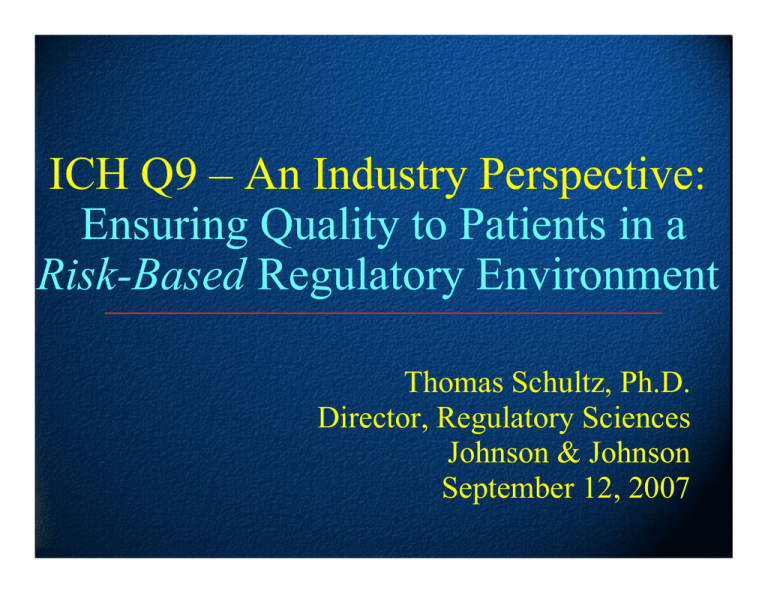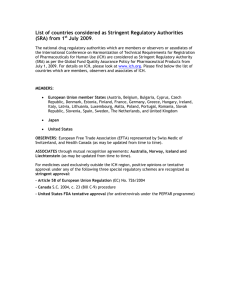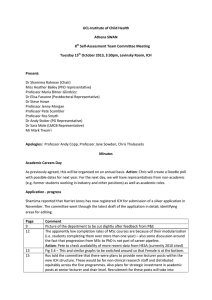An Industry Perspective
advertisement

ICH Q9 – An Industry Perspective: Ensuring Quality to Patients in a Risk-Based Regulatory Environment Thomas Schultz, Ph.D. Director, Regulatory Sciences Johnson & Johnson September 12, 2007 Presentation Overview to Convey Challenges & Opportunities of ICH Q9 • Quality Risk Management – Not A New Concept • Historical review of “Risk-Based” guidance documents • Expectations for “control of risk” based on knowledge shared • Basic Principles of ICH Q9 • Developing an appreciation for terminology and linkage to ICH Q8 • Focus On What is “Critical to Quality” – New Concept? • Target Product Quality Profile as basis for Criticality Analysis • Relationship between Normal Operating & Proven Acceptable Range • Control strategy based what is “critical to quality” • Closing Thoughts “Risk is Inversely Related to Knowledge” Ensuring ‘Fitness for Use’ • Compliance history • Level of product and process understanding acquired • Type of drugs manufactured AND shared at facility • Dosage Form Design • Specific manufacturing processes • Process Design • ICH Q9 (November 2005) • ICH Q8 (November 2005) SUPAC – A Landmark of “Risk-Based” Guidance Document • Scale Up & Post Approval Changes – 1995 • Limit RISK of change based on product KNOWLEDGE • Impact of product/process changes are not same for all drugs • Recognizes importance of solubility & permeability • Biopharmaceutical Classification System • Regulatory requirements based on KNOWLEDGE shared • Comparative dissolution rather than bioequivalence testing possible if required criteria are met ICH Q6A Decision Tree 7(a) Based on BCS Principles (1999) ICH Q3A & 3B: Issued in 1995 and 1996 Employing Risk-Based Approach • Guides Sponsor’s Control strategy for impurities • Scientific knowledge (ICH Q8) • Process capability for drug substance & product • Sets “Normal Operating Range” • Risk Management (ICH Q9) • Thresholds set by reported levels of impurity • Potential impact on Safety and Efficacy • Qualification sets “Proven Acceptable Range” Maintaining Quality Throughout Product Life-Cycle Minimizes ‘Risk’ • “No drug is free of risk” – Pharmacy 101 • Maintain product quality across product life-cycle • Benefit AND Risk to patient is not significantly different than that observed in the clinical program • Effective ‘Risk management’ provides • Proactive means to identify and mitigate potential quality issues • Earliest stages of product development • Appropriate use of control strategy • Improve decision making if quality problem occur What is RISK and Associated Harm? Key Terms to Understand • Risk • “The combination of the probability of occurrence of harm and the severity of that harm” • Harm • “Damage to health, including the damage that can occur from loss of product quality or availability”. • Hazard is defined as “potential source of harm” • Hazard is identified as knowledge shared in Pharmaceutical Development Report (ICH Q8) • What can go wrong? Ch i f d t li t ‘Risk’ Is Ultimately Defined By Impact on Stakeholder • Variety of stakeholders assessing ‘Risk’ • Patients • Medical practitioners • Regulatory agencies • Industry • Etc…. • Based on same Hazard, different ‘stakeholders’ may • Identify different potential harms • Place different probability on each harm occurring • Experience different severities of the harm ‘Quality Risk Management’ Process • “ Risk management is a systematic process for the identification, assessment, control AND COMMUNICATION of risks to the quality of pharmaceuticals across the product lifecycle. Level of effort, formality and documentation of the risk management process should be commensurate with the level of risk.” • ICH Q9 focuses on RISK • Assessment, Control, Communication and Review • Risk Identification beyond scope of guidance • Understanding & Control of ‘Hazard’ linked to ICH Q8 Foundation of Risk Management Linked to Desired Outcome(s) • Target Product Quality Profile • First step in Quality by Design • Developed by multi-functional team • Focus on intended Package Insert • Start at the End and work to the Beginning • Must be consistent with post-approval change • Define what Quality Attributes and related Process Parameters are essential and needed to be controlled to ensure consistently reliable performance in clinic and marketplace Considerations In Development of Target Product Quality Profile For Drug Product Indications and Usage Use in Specific Populations • Pediatric Use • Geriatric Use Dosage and Administration Drug Abuse and Dependence Dosage Forms and Strengths Description Pharmacology • Pharmacodynamics • Pharmacokinetics How Supplied/Storage and Handling Target Product Quality Profile: What Must be Achieved To Reach End • Critical Quality Attributes (CQA) = “Outputs” • A physical, chemical, biological or microbiological property or characteristic that needs to be controlled (directly or indirectly) to ensure product quality (ICH Q8(R) Step 1 Draft 7.0) • May form basis for proposing Specifications • Immediate Release Oral Solid Tablet • Potency • Dissolution or Disintegration requirements • Water Content if susceptible to hydrolysis • Polymorphic form in drug product • Etc… Target Product Quality Profile How to Ensure Desired End is Reached • Critical Process Parameter (CPP) = “Inputs” • A process parameter whose variability impacts a quality attribute and therefore needs to be controlled to ensure the process produces the desired quality. A critical process parameter remains critical even if it is controlled. (ICH Q8(R) Step 1 Draft 7.0) • Manufacturing operation steps (e.g. drying time) • Materials • API, Excipients, Packaging • Analytical methods • Environment • People • Etc Cause& Effect Diagram One Tool to Assess Knowledge & Sources of “Risk” Compression Measurement Systems Capability Tooling Coating Blending Discharge Rate Order of Addition Experience Man-Machine Interface Material Transfer Container Method of Transport Time Speed Surface Finish Training SOPS Cam Selection Feed Hopper Settings Fill Volume Blender Design Hopper and Press Designs Storage Pre- and Compression Forces Method of Discharge Morphology Surface Area PS PS Ergonomics Morphology PS Dust Collection Material Addition Method Humidity API Moisture Machine Speed Drop Height Lactose People Feed Frame Settings Variability in Fill Weight & Forces Shape PS Moisture Environment Accuracy Purity Morphology Temp Detection Limit Dissolution, Assay/Potency, Content Uniformity, Appearance, Stability, Manufacturability, etc.. Precision MCC Moisture Moisture PS Morphology Croscarmellose Cellulose Linearity Surface Area Magnesium Stearate Moisture Raw Materials Range Quantiation Limit Repeatability Analytical Methods Prioritization Matrix Constructed Quality Attributes Blend Time Lube Time Dissolution 1 Assay/ Potency 1 Uniformity 7 1 Appearance 1 3 7 Stability API Surface Area 9 PreCompression Force 1 Compression Force 9 9 3 1 Feed Frame Setting Excipient Particle Size Importance 1 3 1 10 5 3 5 3 Compressing Speed 10 5 5 3 7 3 Yield 10 3 3 Ranking Total 95 95 187 10 126 134 90 60 Percent 13 13 25 1 17 18 12 8 Consider When Surface Area is a Critical Quality Attribute of the Drug Substance … C o n t r o l S t r a t e g y Knowledge Space including Criticality Analysis Proven Acceptable Range Normal Operating Range Adapted from Edge of Failure Edge of Failure Processing Target Knowledge Space including Prior Knowledge Scientists from Around the World Working to Define “Criticality” Critical vs. Non-Critical Attributes & Parameters Impact to Safety or Efficacy? NO Non -critical YES Risk Filter (Examples) > Relationship of NOR to PAR LOW RISK > Edge of Failure Explored > Process Robustness (Cpk) > Impact to Patient if Commercially Unavailable > Control (e.g. Process Analytical Technology) HIGH RISK Draft Output from Washington, D.C. - June 2007 Critical Imaginary Example Describing “Risk Management” Process • A scientist in the Quality Assurance laboratory of Company XYZ confirmed that the stability of the company’s new antibiotic has marginally passed the Potency specifications after 12 months of storage at 30°C/75% RH. The product is now 91% of Label Claim. The primary mechanism of degradation is known to be hydrolysis. The degradation product is also approaching the specification limit and has been shown to be an inactive metabolite. Although packaged in an aluminum blister, it appears that the seal has failed. • Team may construct a Cause and Effect Diagram Three Primary Considerations During Assessment Phase of ‘Risk Management’ • Must fully understand what is considered to be : 1. ‘Hazard’ – What went wrong? 2. ‘At risk’ – What is the general consequence? 3. ‘Harm’ – What is the probability and severity that a stakeholder will be affected by the hazard? • Company XYZ defines “Risk” • Hydrolysis due to package failure = ‘Hazard’ • Reduction of product potency/purity = ‘At Risk’ • Potential lack of efficacy = ‘Harm’ to patient • Potential product recall = ‘Harm’ to industry • Potential public criticism for lack of oversight = ‘Harm’ to regulatory agency Three Control Choices Available When Deciding on Management of Risk 1.Risk mitigation • Focuses on a reduction of severity of harm • Limits negative consequences of particular event • Company XYZ cannot change inherent property 2.Risk reduction • Focuses on reduction of probabilities of harm • Company XYZ corrects cause of package failure 3.Risk acceptance • No additional risk control activities necessary • Must be supported by upper management • Not an viable option in most cases Example of Risk Management as Part of Regulatory Activities “An effective quality risk management approach can further ensure the high quality of the drug product to the patient in providing a proactive means to identify and control potential quality issues with the product during development and manufacturing. Additionally use of quality risk management can also improve the decision making if a quality problem arises. Effective quality risk management can facilitate better and more informed decisions and may provide regulators with greater assurance of a company’s ability to deal with potential risks and may beneficially affect the extent and level of direct regulatory oversight.” • Both a CHALLENGE & OPPORTUNITY for all Closing Thoughts From A Personal Perspective • Risk-Based regulatory environment is not new Stakeholder Challenge Opportunity • Presentation of more scientific • Focus resources on Health Authority interpretation of data by sponsor in what is “critical to Industry assessing risk (ie Criticality report) quality” • Recognition of risk-based • Reliable supply of concepts consistent with Q8 & Q9 medicines to citizens • Potentially longer time to filing • Control strategy based solely on new drug application “critical to quality” • Potential for significantly different • Innovation across specifications world-wide based on unpredictable acceptance of “risk-based” product life-cycle control strategy by HAs THANK YOU for your kind attention. We look very forward to hearing your thoughts regarding Challenges and Opportunities associated with implementation of ICH Q9 during the Panel Discussion as well as your active participation in helping define the future of “Quality Risk Management”


